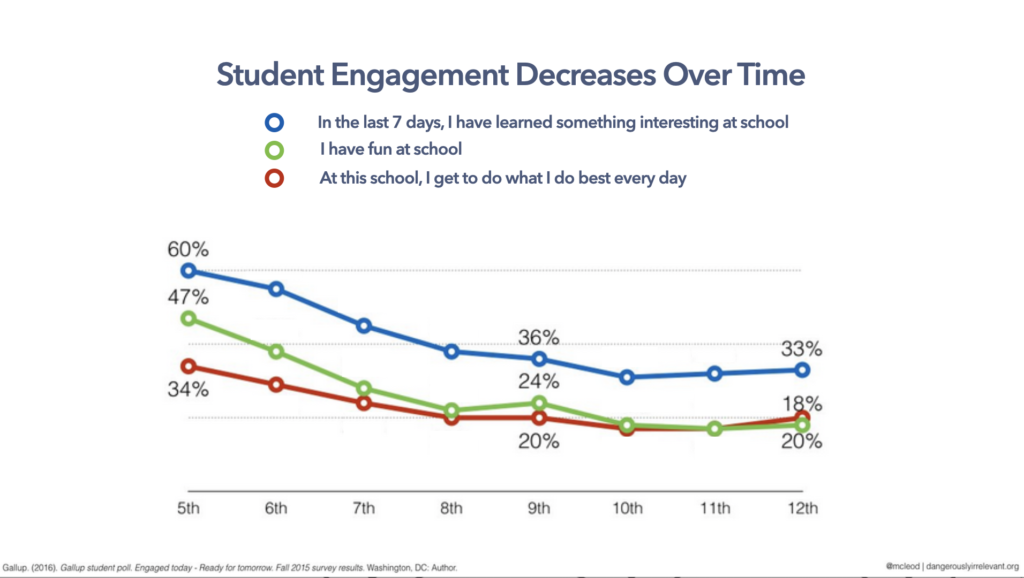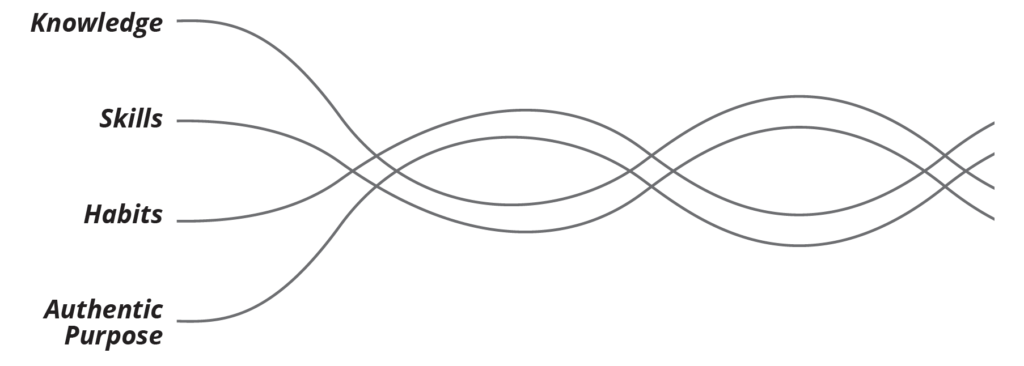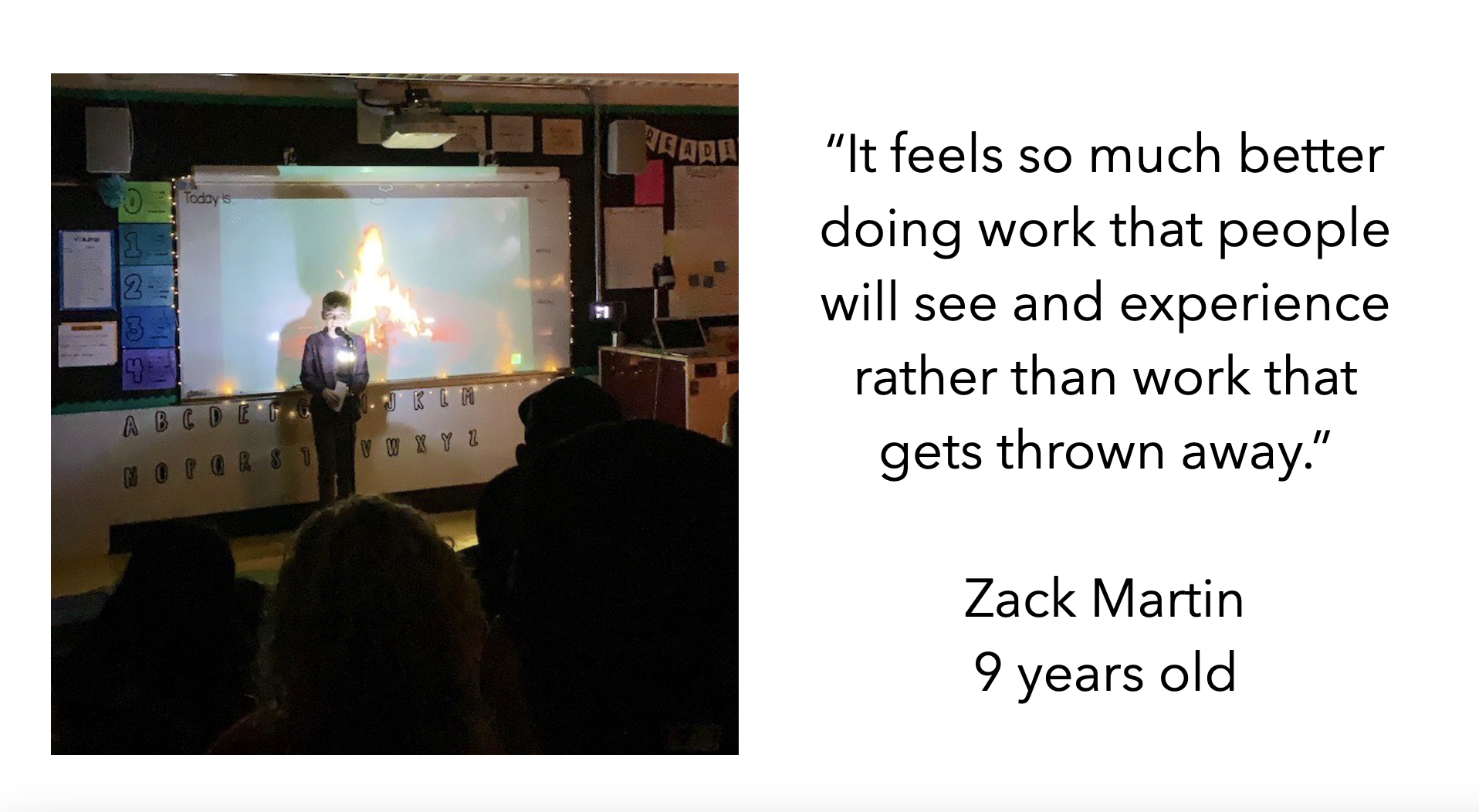Despite the efforts of educators, and initiatives, the Gallup poll highlights that too often students become less engaged in their education the longer they are in school. Much of this is a result of a focus on short-term, extrinsic rewards to coax kids through low-level tasks and provide technology as games or rewards to motivate learners instead of designing authentic and personal learning experiences that draw on their curiosity, passions, and interests. It is important to highlight that if students aren’t motivated and inspired to solve authentic and meaningful problems, it’s not just them who miss out. It’s all of us. In case you haven’t been paying attention, we have some very real and challenging problems that we continue to face in our world. If we want to create more engaged, skilled, and empowered learners and citizens, I would argue that we need to create experiences where they can practice and develop these competencies.

Consider this example from an article by Education Reimagined, “Why Does Memorization Reign Supreme in Traditional Learning?”:
Imagine a student who aspires to climb Mount Denali—a peak that sits over 20,000 feet above sea level. If his training regimen (i.e. curriculum) only consists of memorizing trail maps, reading memoirs by mountaineers, and climbing the hill near his house, it’s clear he would not be developing the skills and stamina needed to successfully complete the journey.
Environments that focus on deeper learning design experiences that not only develop skills learners need but help them apply them so they are transferable in every future learning opportunity. When students learn these skills and can apply them, their sense of confidence and preparedness for postsecondary study and life is increased. I like to think of it as a braid weaving together knowledge, skills, and habits with authentic work, which are interwoven and give purpose to the other.

Authentic Learning
The following questions or prompts are intended to be addressed sequentially, not all at once. One of the biggest criticisms I hear about a learner-centered approach is that students may have fun but they won’t learn the basic skills or key content. However, when these projects, or any learning experiences, are developed with a clear end in mind, it is imperative that they learn and demonstrate the key skills and develop knowledge to complete the project.
Overall Goals
- Why does this project matter?
- How does it connect to your learners and their community?
- What successes have you had so far that you want to build on?
- What are some challenges or goals that you have to improve
- the learning experience?
Success Criteria and Assessment
- What do you want students to learn from this project?
- What are the academic goals (i.e., knowledge, core content)?
- What are your goals to practice or learn new skills?
- What are your goals for habits that students need to develop or practice?
- What does success look like?
- How are you structuring your assignments and tasks to helpstudents meet the success criteria?
- How will you communicate the goals and criteria for success to students?
- How might students self-assess or set goals based on the success criteria?
- When/how might you provide feedback to students based on the success criteria?
Learning Experiences
- What are the key milestones of your project?
- How might these learning experiences provide authentic and relevant experiences that connect to your learners?
- How might students collaborate with peers, experts, or mentors throughout this project?
- How will students learn and develop the skills you will be assessing?
- How might you include opportunities for more voice and choice?
- How might you provide opportunities for sustained inquiry?
Authentic Audience
- How will students share what they know or present their
- learning in a public forum to demonstrate their learning
- (i.e., an event, a production, a public product, or a learning
- exhibition)?
- How might students be engaged in opportunities for critique
- and revision?
- How will you make student learning and growth visible to
- others?
To create alignment between our vision and goals while maximizing our time and resources, we need to determine what we want students to know, what they should be able to do with what they know, and how we can align our learning experiences to provide the best opportunity to achieve the desired outcomes. Our students know when the work isn’t authentic, as exemplified by a comment my son made when I asked him to complete his homework. “Mom, why does it matter? It’s just trash can work.” He said all his worksheets just went in the trash can anyway, and it made him feel like his work (and he) didn’t matter.



Our students know when the work isn’t authentic. This is profound. Who wants to feel like their work doesn’t matter?
They sure do! When there isn’t an authentic purpose, authentic learning cannot take place.
I loved reading this blog not just as a reminder of how to “Design Authentic Projects,” but also to reengage with students as they come back to the classroom after a year and a half of being virtual. The process of designing authentic projects is one of the most creative and expansive experiences we can have as educators. In an effort to create meaningful, engaging learning opportunities for students we have to know our students’ interests and strengths. I think the foundation of creating a truly memorable project goes back to your first two bullet points: “Overall Goals: Why does this project matter, and how does it connect to your learners and their community.” Reconnecting with students and the community after being isolated for so long will surely have a profound impact on learning experiences. Who can we bring into the classroom now as an authentic audience? What are problems/gaps in our community currently that need to be addressed? How have we grown as a school, community, country since we left school in March 2019? I am looking forward to working with my team to create more authentic projects based on some of these questions. Thank you for the excellent primer! Kids must know their work is not trash!